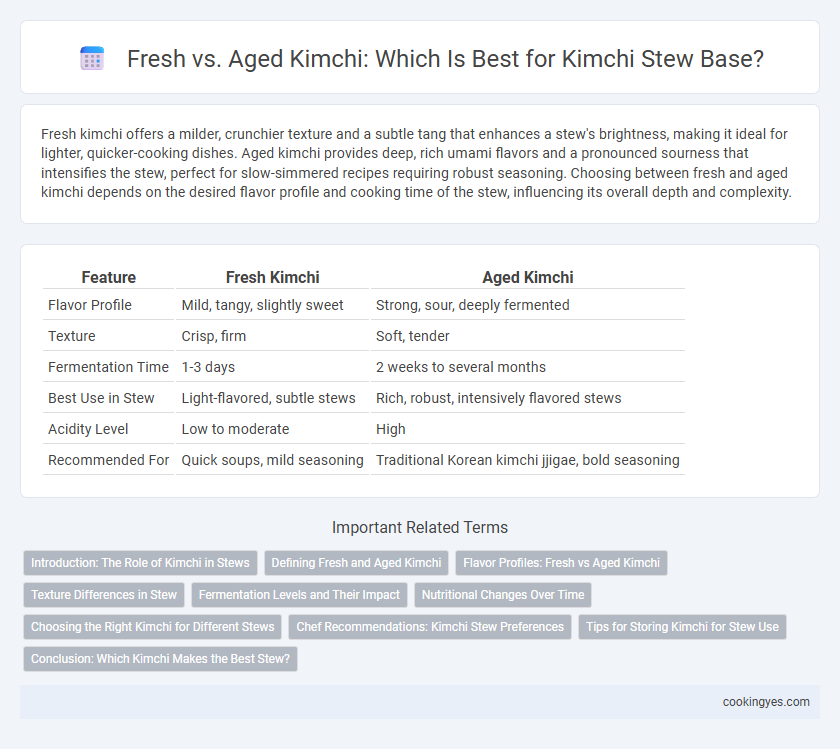Fresh kimchi offers a milder, crunchier texture and a subtle tang that enhances a stew's brightness, making it ideal for lighter, quicker-cooking dishes. Aged kimchi provides deep, rich umami flavors and a pronounced sourness that intensifies the stew, perfect for slow-simmered recipes requiring robust seasoning. Choosing between fresh and aged kimchi depends on the desired flavor profile and cooking time of the stew, influencing its overall depth and complexity.
Table of Comparison
| Feature | Fresh Kimchi | Aged Kimchi |
|---|---|---|
| Flavor Profile | Mild, tangy, slightly sweet | Strong, sour, deeply fermented |
| Texture | Crisp, firm | Soft, tender |
| Fermentation Time | 1-3 days | 2 weeks to several months |
| Best Use in Stew | Light-flavored, subtle stews | Rich, robust, intensively flavored stews |
| Acidity Level | Low to moderate | High |
| Recommended For | Quick soups, mild seasoning | Traditional Korean kimchi jjigae, bold seasoning |
Introduction: The Role of Kimchi in Stews
Kimchi serves as a fundamental ingredient in Korean stews, providing a distinct tangy and spicy flavor that defines the dish's character. Fresh kimchi offers a crisp texture and vibrant taste, ideal for lighter broths and subtle seasoning. Aged kimchi, rich in fermented depth, intensifies the stew's flavor profile, creating a robust and hearty base essential for traditional kimchi jjigae.
Defining Fresh and Aged Kimchi
Fresh kimchi typically refers to newly fermented cabbage, characterized by a crisp texture and mild, tangy flavor ideal for light, refreshing stews. Aged kimchi undergoes extended fermentation, developing a deeper, more pungent taste with softer texture, which enhances rich, hearty stew bases. The choice between fresh and aged kimchi significantly impacts the stew's flavor profile and complexity.
Flavor Profiles: Fresh vs Aged Kimchi
Fresh kimchi offers a crisp, tangy flavor with vibrant acidity and a juicy crunch, ideal for a stew base that requires bright, sharp notes. Aged kimchi, on the other hand, delivers a deeper umami richness and mellowed sourness, creating a robust, complex broth with intensified savory flavors. The fermentation process enhances lactic acid bacteria, which transforms the kimchi's flavor from fresh and zesty to rich and pungent, influencing the stew's overall taste profile.
Texture Differences in Stew
Fresh kimchi offers a crisp and crunchy texture that adds a vibrant bite to stew, enhancing the overall mouthfeel and providing a refreshing contrast to softer ingredients. Aged kimchi, by contrast, brings a softer, more tender texture with deeper fermentation flavors, which integrates seamlessly into stews, enriching the broth with umami complexity. The textural difference between fresh and aged kimchi significantly influences the stew's layering, where fresh kimchi creates distinct, textured bites while aged kimchi contributes to a smoother, more cohesive base.
Fermentation Levels and Their Impact
Fresh kimchi offers a mild, crisp flavor with lower fermentation levels, ideal for a subtle stew base that enhances other ingredients without overwhelming them. Aged kimchi undergoes extended fermentation, developing a deeper, tangier taste rich in probiotics and umami, significantly intensifying the stew's flavor profile. The choice between fresh and aged kimchi directly impacts the stew's acidity, complexity, and depth, making fermentation levels a key factor in achieving desired taste balance.
Nutritional Changes Over Time
Fresh kimchi contains higher levels of vitamin C and live probiotics essential for digestive health, while aged kimchi develops increased concentrations of lactic acid and amino acids, enhancing its umami flavor and probiotic richness. Over time, fermentation boosts the bioavailability of nutrients, such as B vitamins and antioxidants, making aged kimchi a more potent stew base for nutrient absorption. The gradual breakdown of sugars and fibers during aging also improves the stew's depth of flavor and digestive benefits.
Choosing the Right Kimchi for Different Stews
Fresh kimchi offers a crisp texture and mild tang, making it ideal for lighter stews like kimchi jjigae where a subtle ferment accentuates the broth. Aged kimchi, with its deep umami and pronounced sourness, enhances heartier stews such as kimchi bokkeum jjigae by imparting rich, robust flavors. Selecting the right kimchi based on its fermentation stage ensures balanced acidity and depth, optimizing the stew's complexity and overall taste.
Chef Recommendations: Kimchi Stew Preferences
Chefs recommend using aged kimchi for stew bases due to its deeper, tangier flavor profile that enriches the broth and enhances umami. Fresh kimchi provides a milder, crisp texture but lacks the intensity needed for robust kimchi stew. Professional kitchens often balance both, starting with aged kimchi for depth and adding fresh kimchi later to maintain some crunch and brightness.
Tips for Storing Kimchi for Stew Use
For stew bases, fresh kimchi offers a mild, crunchy texture and bright flavor, while aged kimchi provides a deeper, more robust tang ideal for rich, savory stews. Store kimchi in an airtight container at a consistent refrigerator temperature around 4degC (39degF) to slow fermentation and maintain optimal flavor balance. Using a separate container for stew kimchi prevents over-fermentation of the main batch and preserves the distinct taste needed for cooking.
Conclusion: Which Kimchi Makes the Best Stew?
Aged kimchi offers a richer, more complex flavor profile ideal for stew bases due to its enhanced fermentation, which intensifies umami and acidity. Fresh kimchi provides a mild, crisp taste that can dilute stew flavors, making it less suitable for depth in stews. For a robust and savory kimchi stew, aged kimchi is the preferred choice.
Fresh vs Aged Kimchi for Stew Base Infographic

 cookingyes.com
cookingyes.com